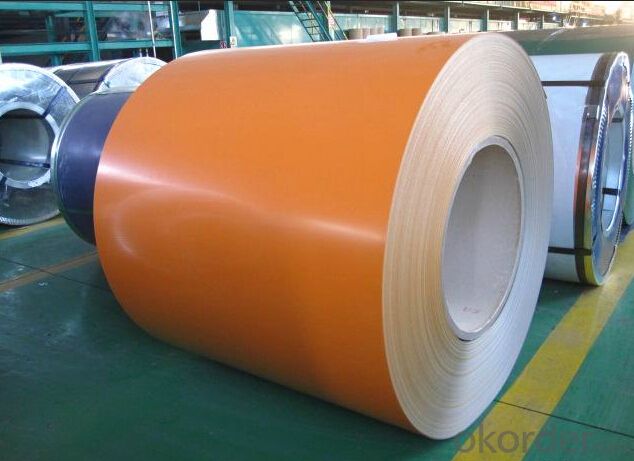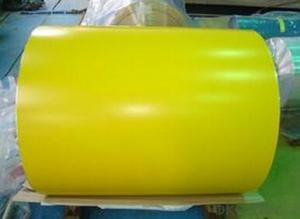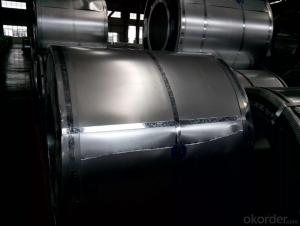Best Prepainted Galvanized steel Coil JIW
- Loading Port:
- Tianjin
- Payment Terms:
- TT OR LC
- Min Order Qty:
- 11 m.t.
- Supply Capability:
- 11 m.t./month
OKorder Service Pledge
OKorder Financial Service
You Might Also Like
Item specifice
1.Structure of Prepainted Galvanized steel Coil :
With Gi as base metal,after pretreatmet (degrease and chemical treatment) and liquid dope with several Layers of color,then after firing and cooling,finally the plate steel is called prepainted galvanized steel ( PPGI) .Prepainted galvanized steel is good capable of decoration ,molding,corrosion resistance The carbon in typical steel alloys may contribute up to 2.1% of its weight. Varying the amount of alloying elements, their formation in the steel either as solute elements, or as precipitated phases, retards the movement of those dislocations that make iron comparatively ductile and weak, and thus controls qualities such as the hardness, ductility, and tensile strength of the resulting steel. Steel's strength compared to pure iron is only possible at the expense of ductility, of which iron has an excess.
2.Main Features of Prepainted Galvanized steel Coil:
• Excellent process capability
• Smooth and flat surface
• Workability, durability
• Excellent heat resistance performance
• High strength
• Good formability
• Good visual effect
Although steel had been produced in bloomery furnaces for thousands of years, steel's use expanded extensively after more efficient production methods were devised in the 17th century for blister steel and then crucible steel. With the invention of the Bessemer process in the mid-19th century, a new era of mass-produced steel began. This was followed by Siemens-Martin process and then Gilchrist-Thomas process that refined the quality of steel. With their introductions, mild steel replacedwrought iron.
3.Prepainted Galvanized steel Coil Images

4.Prepainted Galvanized steel Coil Specification
Standard:ASTM, GB,JIS,JIS G3302 ASTM 755 EN10169
Grade: DX51D CGCC CS
Thickness: 0.13mm~3.0mm,
Width: 1250,600-1250mm
Coil weight:3-12 MT
Coil ID:508/610mm
Chemical composition:
C | Si | Mn | Cr | Ni | P | S |
0.150 | 0.476 | 11.231 | 12.50 | 0.900 | 0.039 | 0.010
|
5.FAQ of Prepainted Galvanized steel Coi
We have organized several common questions for our clients,may help you sincerely:
1.How do you control your quality
We have established the international advanced quality management system,every link from raw material to final product we have strict quality test;We resolutely put an end to unqualified products flowing into the market. At the same time, we will provide necessary follow-up service assurance.
2.how long we will receive the goods ?
After receiving your deposit or workable lc ,our normal shipment date is 15-20days,and it takes around 28 days to reach your port of destination. But is up to different destination
3. what is your moq
Normally our moq is 25per size ,but it is up to different size
- Q:How are steel strips processed for surface painting?
- To ensure proper adhesion and durability of the paint, steel strips undergo a series of steps during surface painting. The process begins by cleaning the strips to remove contaminants like dirt, oil, or rust. This can be done mechanically, using methods such as abrasive blasting, or chemically, through degreasing. Once the strips are clean, a coating is applied to enhance paint adhesion. This can involve using a primer or a conversion coating, which chemically reacts with the surface to create a bond between the steel and the paint. The choice of coating depends on the specific requirements of the application. After the coating is applied, the strips are dried or cured to allow for complete bonding. The drying process can be accomplished through air drying, oven baking, or infrared heaters, depending on the type of coating and desired curing time. Once the strips are properly cured, they are ready for the paint application. Various methods can be used, such as spraying, dipping, or roller coating, depending on factors like strip size, shape, desired finish, and production volume. After the paint is applied, additional steps may be taken to ensure full bonding and drying. This can be achieved through natural drying or specialized equipment like drying ovens or UV curing systems. Overall, the process of preparing steel strips for surface painting involves cleaning, surface treatment, coating application, drying or curing, and final inspection to achieve a high-quality paint finish that is corrosion-resistant and visually appealing.
- Q:How are steel strips processed for surface stamping?
- Steel strips are processed for surface stamping through a series of steps including cleaning, coating, drying, and precision stamping. Initially, the steel strips are thoroughly cleaned to remove any impurities or contaminants. Next, a protective coating is applied to enhance corrosion resistance and improve surface finish. After coating, the strips are dried to remove any moisture. Finally, they undergo precision stamping, where a customized pattern or design is imprinted onto the surface using specialized tools and techniques.
- Q:How are steel strips used in the production of automotive exhaust systems?
- Steel strips are an essential component in the production of automotive exhaust systems. These strips are typically made from high-quality stainless steel due to its durability, heat resistance, and corrosion resistance properties. One of the primary uses of steel strips in exhaust systems is for the manufacturing of exhaust pipes. These pipes need to be able to withstand extreme temperatures and corrosive gases emitted from the engine. Steel strips are rolled into cylindrical shapes and welded together to form the main body of the exhaust pipe. The strength and heat resistance of the steel strips ensure that the pipe can endure the harsh conditions within the exhaust system. Additionally, steel strips are also used in the production of various components within the exhaust system, such as mufflers and resonators. Mufflers are responsible for reducing the noise produced by the engine by using baffles and chambers to dissipate sound waves. Steel strips are formed and shaped to create the outer shell of the muffler, providing structural integrity and durability. Resonators, on the other hand, are used to fine-tune the exhaust sound and minimize unwanted vibrations. Steel strips are used to construct the inner chambers and baffles within the resonator to achieve the desired acoustic effects. Furthermore, steel strips play a crucial role in the production of exhaust manifold, which collects exhaust gases from each cylinder and directs them into the exhaust system. The steel strips are formed into intricate shapes and welded together to create a strong and leak-free manifold that can withstand the high temperatures and pressures. Overall, steel strips are an integral part of the production of automotive exhaust systems. Their strength, heat resistance, and corrosion resistance properties make them ideal for constructing various components within the system, ensuring its durability, performance, and longevity.
- Q:How are steel strips coated with a protective oil film?
- The process of oiling or oil coating involves applying an oil-based substance onto steel strips to create a protective film. This film safeguards the strips from corrosion and other forms of harm. There are different methods to apply the oil coating, such as immersion, brushing, spraying, or roll-coating. In immersion coating, the strips are submerged in an oil bath, allowing the oil to permeate the surface and create a protective film. Brushing involves manually applying the oil using brushes or rollers, ensuring an even and consistent coating. Spraying involves atomizing the oil and spraying it onto the strips, covering the entire surface. Roll-coating, as the name suggests, includes passing the strips through oil-soaked rollers to transfer the oil onto the surface. The choice of oil for coating varies based on the specific requirements and desired properties of the strips. Mineral oils, synthetic oils, rust preventatives, and lubricants are commonly used. These oils are selected for their ability to provide corrosion protection, lubrication, and other desired characteristics. After the oil coating is applied, additional processes like drying or curing may be necessary to ensure proper adherence of the film to the surface. This can involve passing the strips through ovens or using other methods to remove excess oil or moisture and promote bonding of the protective film. Overall, coating steel strips with a protective oil film is crucial to enhance their durability and prevent damage during storage, transportation, and subsequent processing. The oil film acts as a barrier against moisture, oxygen, and other elements that can cause corrosion, rusting, or surface defects.
- Q:How do steel strips compare to other materials in terms of cost and performance?
- Compared to other materials, steel strips have cost-effective benefits and excellent performance in various applications. The affordability of steel strips stems from steel being widely available and relatively inexpensive, making it a more affordable option than aluminum or titanium alternatives. This cost advantage has made steel strips a popular choice in industries where cost-efficiency is essential. In terms of performance, steel strips possess several advantages. Firstly, steel is renowned for its high strength and durability, enabling steel strips to withstand heavy loads and resist deformation better than many other materials. This strength makes steel strips suitable for applications that require structural integrity, such as the construction and automotive industries. Furthermore, steel strips possess exceptional corrosion resistance properties, especially when coated or galvanized. This resistance to rust and corrosion ensures the longevity of steel strips, thereby reducing maintenance and replacement costs. Additionally, steel strips can endure extreme temperatures, making them suitable for use in challenging environments. Moreover, steel strips exhibit good electrical and thermal conductivity, making them ideal for applications that require heat dissipation or electrical grounding. Steel strips are also highly machinable and can be easily formed into various shapes, offering versatility and flexibility in design. However, it is crucial to note that the choice of material depends on the specific requirements of the application. While steel strips offer numerous advantages, there may be other materials that outperform steel in certain aspects, such as weight or specific chemical properties. Therefore, it is essential to consider the specific needs and constraints of each project before determining the most suitable material.
- Q:Can steel strips be used in the renewable energy sector?
- Yes, steel strips can be used in the renewable energy sector. Steel strips are commonly used in the construction of wind turbines, solar panel frames, and other renewable energy infrastructure. They provide structural support, durability, and resistance to corrosion, making them an ideal choice for various applications in the renewable energy sector.
- Q:How are steel strips protected against extreme weather conditions?
- Steel strips are protected against extreme weather conditions through a process called galvanization. This involves coating the steel with a layer of zinc, which acts as a barrier against moisture, corrosion, and other environmental factors. The zinc coating provides long-lasting protection, ensuring the steel strips remain durable and resistant to extreme weather conditions.
- Q:Can steel strips be used in the production of metal roofing panels?
- Yes, steel strips can be used in the production of metal roofing panels. Steel strips are commonly used as the base material for metal roofing panels due to their strength, durability, and resistance to corrosion. They provide a stable foundation for the roofing panels and contribute to their overall structural integrity.
- Q:How are steel strips waterjet cut?
- Using a highly pressurized stream of water mixed with abrasive particles, steel strips undergo waterjet cutting. This involves directing the waterjet onto the steel strip, which is held in place by a cutting bed or fixture. The high-pressure pump generates the waterjet, typically with a range of 30,000 to 90,000 psi. To create a narrow and high-velocity stream, the waterjet is focused through a small orifice, usually around 0.010 to 0.060 inches in diameter. To cut the steel strip, a computer-controlled system moves the waterjet along the desired cutting path. As the high-pressure waterjet stream makes contact, it erodes the steel material and effectively slices through the strip. The addition of abrasive particles, such as garnet, helps accelerate the erosion of the steel and enhances the cutting process. Waterjet cutting offers numerous advantages for cutting steel strips. It provides a precise and clean cut with minimal heat-affected zones, which prevents distortion or warping of the steel. Moreover, the process can cut through various thicknesses of steel strips, ranging from thin gauges to thick plates. Additionally, waterjet cutting is a versatile method that can handle complex shapes and intricate designs, making it suitable for a wide range of applications in industries such as automotive, aerospace, and manufacturing. In conclusion, waterjet cutting of steel strips is an efficient and accurate process that utilizes the power of water and abrasive particles to achieve precise and high-quality cuts.
- Q:How are steel strips used in the production of automotive components?
- The strength, durability, and versatility of steel strips make them widely used in the production of automotive components. These strips are typically made from high-quality steel alloy and come in different thicknesses and widths to meet different manufacturing needs. One way steel strips are commonly used in automotive production is for fabricating body panels. Specialized machinery is used to stamp or press these strips into shape, creating components like doors, hoods, roofs, and fenders. The strength of steel allows for thinner panels, reducing vehicle weight while maintaining structural integrity and safety. Steel strips are also commonly used for suspension and chassis components. These strips can be cut, bent, and welded to form brackets, reinforcements, and other parts. The strong and rigid nature of steel ensures these components can withstand the heavy loads and stresses experienced by vehicles. Engine and transmission components are also manufactured using steel strips. These strips can be shaped and then heat-treated or machined to achieve the desired strength and precision. Examples of such components include gears, shafts, valves, and crankshafts. The high wear resistance and heat resistance of steel make it an ideal material for these critical components. In addition to their mechanical properties, steel strips are valued for their corrosion resistance. Automotive components made from steel strips are often coated with protective layers like zinc or paint to prevent rusting and ensure longevity. In conclusion, steel strips are crucial in the production of automotive components due to their strength, durability, versatility, and corrosion resistance. They are used in various applications, from body panels to suspension and engine components, contributing to overall vehicle performance, safety, and longevity.
1. Manufacturer Overview |
|
|---|---|
| Location | |
| Year Established | |
| Annual Output Value | |
| Main Markets | |
| Company Certifications | |
2. Manufacturer Certificates |
|
|---|---|
| a) Certification Name | |
| Range | |
| Reference | |
| Validity Period | |
3. Manufacturer Capability |
|
|---|---|
| a)Trade Capacity | |
| Nearest Port | |
| Export Percentage | |
| No.of Employees in Trade Department | |
| Language Spoken: | |
| b)Factory Information | |
| Factory Size: | |
| No. of Production Lines | |
| Contract Manufacturing | |
| Product Price Range | |
Send your message to us
Best Prepainted Galvanized steel Coil JIW
- Loading Port:
- Tianjin
- Payment Terms:
- TT OR LC
- Min Order Qty:
- 11 m.t.
- Supply Capability:
- 11 m.t./month
OKorder Service Pledge
OKorder Financial Service
Similar products
New products
Hot products
Related keywords




























